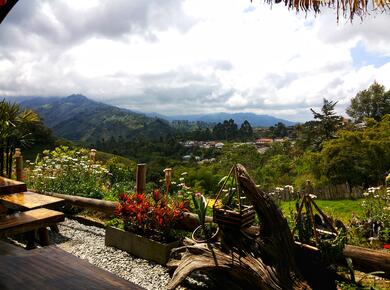Posted: January 20, 2022
On 23 September 2021, UN Secretary-General António Guterres said that the Intergovernmental Panel report on climate change was “a code red for humanity.” And yet Guterres was hopeful, saying “it is not too late to act to ensure that climate action contributes to international peace and security.” For Guterres, nations must work together because peace today cannot be separated from the problems of climate.
For Christians, a theological framework is needed to relate alarming climate problems to our commitment to peace. The story of creation provides this framework, where humanity’s existence is part of the Creator’s beautiful ordering of climate.
In Genesis, the first book of the Bible, there are two stories of creation.
The first story in Genesis 1 is famous to many of us. In it, the Creator made the heavens and earth in six days. This story sketches the creation in orderly, poetic, and rhythmic sentences, ones that can be found in religious rituals or church Sunday services.
In this story, the Creator saw that disorder was not good and thus separated light from darkness, water from dry land, and so on. These separations prepared for the coming of human beings as the pinnacle of creation. On the sixth day, God created humans after nature, plants, and animals. Man and woman were created in God’s image at the same time.
Yet Genesis 2 tells the story from another angle, reversing the order of creation. God created man first, then plants, and animals. And finally, God created woman as man’s helper. The importance of human beings can be seen in their place as the first and last of creation. But here, the creation of humans, plants and animals occur within the story of God preparing climate. The text reads that “when no plant of the field was yet in the earth and no herb of the field had yet sprung up – for the Lord God had not caused it to rain upon the earth, and there was no one to till the ground; but a stream would rise from the earth, and water the whole face of the ground—then the Lord God formed man from the dust of the ground, and breathed into his nostrils the breath of life; and the man became a living being” (Genesis 2:5-7).
Rain and stream are, indeed, related to climate. The word for stream here can also mean steam or mist. Streams of water rise from earth to flood the soil and water the dry land. And steam from the ground fills the air with water and falls as rain. Here we are given a beautiful story of climate origin. And then the first human was created from dust of the ground – moist dust, permeated by mist which rose from the earth.
Here is what is important: More than a story of humble beginning, the creation of human beings in Genesis 2 portrays humans as part of the climate story. The Creator prepared climate before creating living beings, including humans.
As the first and the last of God’s creation, humans are protectors not only of the garden but also the whole creation (Genesis 2:15-17). They must “till the ground,” the very ground from which humans came to be. But it is also the moist ground, the ground which will bring fruits because God has prepared it through ordering climate and by the work of human hands.
Here, humanity’s role is to be the mediator between earth and its Creator. Humans are responsible to the Creator for the preservation of the ground because their existence is dependent on the moist ground in the climate story. As such, humans are not only God’s emissaries to earth but also mediators who bring the groanings of all creatures to the Creator.
Praying is the first concrete step through which we can practice our mediatorial role in today’s climate calamities. When we pray, we reconnect our beautiful yet fractured earth to the Creator. In praying, we connect our desire with those who yearn for clean water and air, because, in the words of scholar and policymaker Maxine Burkett, those who “suffer most acutely [from climate disaster] are also those who are the least responsible for the crisis to date.”
When we pray, God will open our hearts to concrete actions as individuals, communities of faith, and policymakers for the peace and security of our common home. Friends, let us continue to pray.
—Nindyo Sasongko, a Mennonite pastor from Indonesia, is a PhD candidate in Systematic Theology at Fordham University, New York, theologian in residence at Manhattan Mennonite Fellowship, NYC, and a member of the MWC Creation Care Task Force.



Comments: